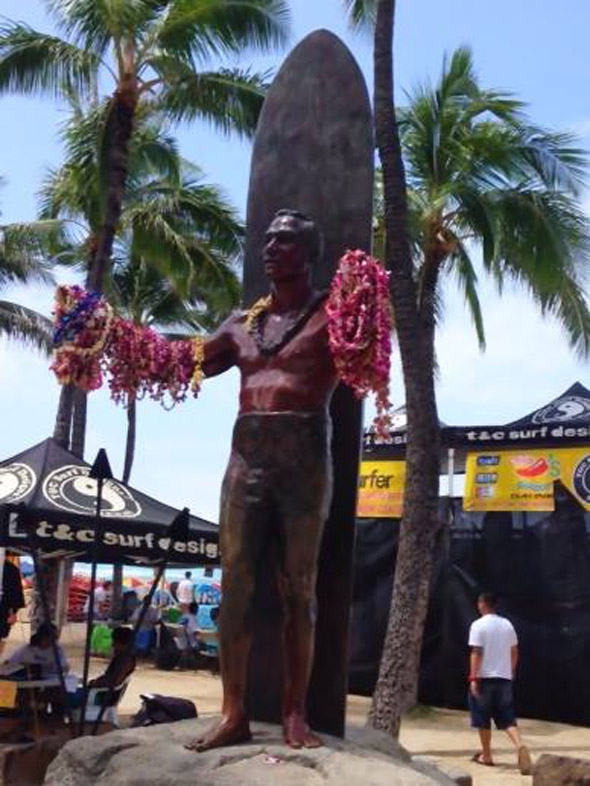DUKE KAHANAMOKU: HAWAII’S AMBASSADOR OF ALOHA

Photo Credit: Crystal Yamasaki
When it comes to ambassadors of aloha, surfing icons and Olympic medalists there are a lot of names swimming out there. But few capture the spirit of Hawaii and the raw talents as a waterman quite like Hawaii legend, Duke Kahanamoku.
A dominating figure in the world of surfing, he has captured the hearts of local residents and people around the world, winning Olympic gold five times for the United States. In his lesser-known roles, he was a law enforcement officer, actor and beach volleyball player. But no matter his position, he was always an ambassador of the aloha spirit – a title which he is still most celebrated for to this day.
Kahanamoku Keiki
Born August 24, 1890, in Honolulu into a family who had long made waves as surfers, swimmers and paddlers, his future seemed all but fate. The first of nine children to Duke Halapua and Julia Paoa Kahanamoku, he was named after his father and was not actually a duke though his family did have some royal ties – his grandparents served as attendants for the Kamehamehas and his family descended from the Alapainui line which once ruled Hawaii Island.
Kahanamoku attended Waikiki Grammar School, Kaahumanu School and the Kamehameha School for Boys though he never graduated. At the age of three, his family moved into Waikiki. It was there – just as the sport of surfing was staging a revival – that Duke grew up, honing his swimming and surfing skills on a wooden papa nui (a traditional surfboard designed out of wood from a koa tree).
Medal Madness
There is no doubt that his talent as a swimmer came – at least in small part – from his hours spent playing in the waves of Waikiki. In fact, Kahanamoku was in the truest sense a waterman, and had a natural talent for many water sports including bodysurfing, surfing, diving, sailing, and paddling.
But while he was known as a surfer, it was in the sport of swimming that he was able to make a real mark. In the summer of 1911 he broke the American 50-yard record by more than a second and the 100-yard world record by more than four seconds at the young age of 20.
Kahanamoku easily qualified for the 1912 Olympics in Stockholm where he won gold in the 100-meter freestyle and silver in the men’s 4×200 meter freestyle relay. Eight years later in the 1920 Antwerp Olympics he won gold in the 100-meter freestyle and the 400-meter freestyle relay. By his last Olympic competition in 1924, Kahanamoku had earned the nicknames “human fish” and the “Bronzed Duke.” At the age of 34, he earned silver in the 100 meter freestyle – his brother, Samuel Kahanamoku took bronze.
Traveling the world for swimming exhibitions and competitions, he had the chance to showcase and popularize the sport of surfing – previously unknown outside of Hawaii. The surfing exhibition that he conducted at Freshwater Bay in Sydney is considered by many to be the inauguration of surfing in Australia. To this day a statue of Kahanamoku stands in Freshwater Beach in New South Wales, honoring that legacy.
Walking on Water
After his Olympic heyday, Kahanamoku continued surfing until his late 60s, and sailed and swam till his mid-70s. He was the first person inducted into the International Surfing Magazine Hall of Fame in 1966 and the Huntington Beach Surfing Walk of Fame in 1994. The Duke Kahanamoku Award was given to the best all-around surfer at annual United States Surfing Championships from 1964 through 1972.
His legend has been honored in many ways. Fellow surfers and beachgoers can find a 17-and-a-half-foot bronze statue of him and his surfboard at Kuhio Beach in Waikiki where people pay their respects to Kahanamoku by draping flower lei over his arms and laying them at his feet.
Duke Kahanamoku reinvented surfing and brought the Hawaiian culture to the world. Many surfers still look up to Kahanamoku as a surfing idol and some even consider him the father of surfing. He will forever be honored and remembered for all that he has done for surfing and swimming. And in Waikiki, his statue will forever stand, watching over the waves and welcoming people with open arms.
